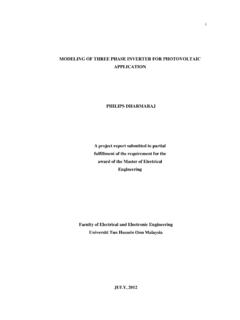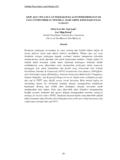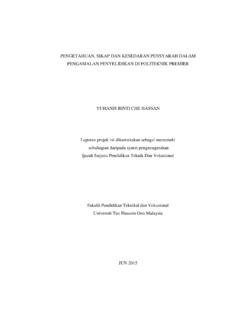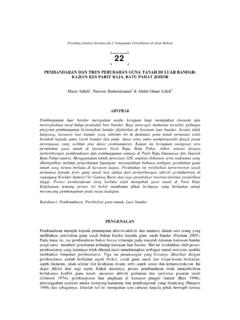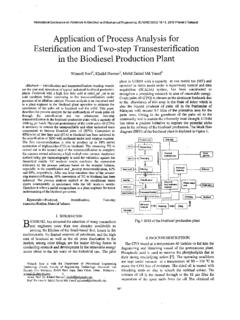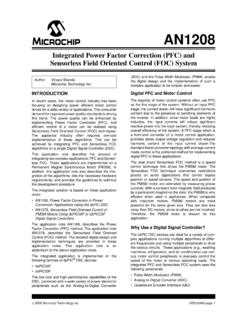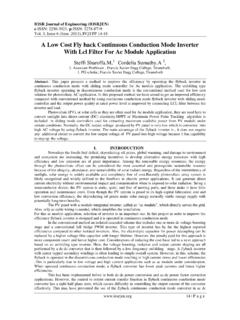Transcription of DESIGN AND SIMULATION OF THREE PHASE …
1 DESIGN AND SIMULATION OF THREE PHASE rectifier WITH power FACTOR correction muhd halalluddin BIN abdul rahim A thesis submitted in fulfillment of the requirement for the award of the Degree of Master of Engineering Faculty of Electrical & Electronic Engineering Tun Hussein Onn University of Malaysia JULY 2012 v ABSTRACT The Switch Mode power Supplies (SMPS) are a multi-million dollar industry and continuously growing industry within the field of power electronics. SMPS is widely been used in communication, computers and industrial. The Unity power Factor (UPF) rectifier has become an important DESIGN issue as a consequence of recent legislation. European legislation restricts the harmonic content of power supplies. The advantages of UPF are more than legislative compliance. The advantages include greater efficiency, larger power density and improved power quality result in economic benefits to the electricity service provider.
2 The goal of this thesis is to develop a unity power factor rectifier . The motivation in developing this product was to develop a regulated power supply capable of producing power with low level of harmonic current distortion. This project observes the current, voltage waveform and also the harmonics component before and after the compensation to the nonlinear load. In this work MATLAB/SIMULINK power system toolbox is used to simulate the proposed system. SIMULATION results are presented and the improvement in the supply current will show in this work. vi ABSTRAK Bekalan Kuasa Mod Pensuisan merupakan industri yang menguntungkan dan berkembang pesat secara berterusan terutamanya dalam bidang elektronik kuasa. Ianya digunakan secara meluas dalam bidang perhubungan, komputer dan juga elektronik kuasa.
3 Masalah yang dihadapi oleh pereka penerus adalah kesan perlaksanaan undang undang terkini. Perundangan Eropah menghadkan kandungan harmonik pada bekalan kuasa. UPF mempunyai kelebihan dalam mematuhi undang undang tersebut. UPF juga mempunyai kelebihan lain termasuk kecekapan, ketumpatan kuasa yang lebih besar dan meningkatkan kualiti kuasa yang akan memberi manfaat pada ekonomi terutama kepada pembekal perkhidmatan elektrik. Matlamat tesis ini adalah untuk membangunkan penerus berfaktor kuasa tinggi. Motivasi menghasilkan produk ini adalah untuk mmencipta bekalan kuasa terkawal yang mampu menghasilkan kuasa dengan tahap herotan harmonik yang rendah. Arus, gelombang voltan dan juga komponen harmonic sebelum dan selepas dibaiki akan diperhatikan dalam projek ini. Untuk kerja-kerja ini, program MATLAB / Simulink digunakan untuk mensimulasi sistem yang dicadangkan.
4 Keputusan simulasi dan peningkatan arus bekalan akan dibentangkan dalam projek ini. vii CONTENTS TITLE i DECLARATION ii DEDICATION iii ACKNOWLEDGMENT iv ABSTRACT v ABSTRAK vi CONTENTS
5 Vii LIST OF TABLES x LIST OF FIGURES xi LIST OF SYMBOLS xiv LIST OF APPENDICES xvi CHAPTER 1 INTRODUCTION 1 Background 1 Problem Statements 3 Research Objectives 4 Research Methodology 5 Thesis Outline 7 CHAPTER 2 LITERATURE REVIEW 8 Introduction 8 power Factor 8 Benefits of power Factor correction (PFC)
6 10 viii Disadvantages of Low power Factor 10 power Factor correction 11 Passive PFC 12 Active PFC 13 Existing THREE PHASE power Converter Topologies 14 rectifier Topology using Passive Input Filter 16 Boost Derived power Converter Topologies 17 Six Switches Boost power Converter 17 Four Switches Boost power Converter 18 THREE Switches Boost power Converter 19 Single Switch Boost power Converter 20 Vienna rectifier 21 Buck Derived power Converter Topologies 22 Six Switches Single-Stage Buck power Converter 22 Six Switches Two-Stage Buck power Converter 23 Single Switch Buck power Converter 24 Buck Boost Converters 25 CHAPTER 3 METHODOLOGY 26 Introduction 26 Process of 3 PHASE rectifier with power Factor correction 27 Operating Strategy for 3 PHASE Sinusoidal PWM rectifier 28 Rectifying Operation 29 Active Filtering Operation 30 Generating of PWM Signals 31 THREE PHASE rectifier with Active power Filter 33 The Control System 35 DC-bus voltage Control 37 Digital Low Pass Filter 39 ix CHAPTER 4 SIMULATION RESULTS AND ANALYSIS 41
7 Introduction 41 System Modelling via MATLAB/Simulink 42 3 PHASE Pulse Width Modulated (PWM) Rectifiers 42 Analysis for THREE PHASE PWM rectifier 44 THREE PHASE rectifier with Active power Filter 45 Nonlinear Load 46 Analysis for Nonlinear Load 51 CHAPTER 5 CONCLUSIONS AND RECOMMENDATION 53 FOR FUTURE WORK Conclusions 53 Recommendations for Future Work 54 REFERENCES 55 x LIST OF TABLES 4. 1 Circuit Parameters For 3 PHASE PWM Rectifiers 43 4. 2 Circuit Parameters of Active power Filter 48xi LIST OF FIGURES 1. 1 Workflow for the research 6 2. 1 power Factor Triangle 10 2. 2 Block Diagram of an APFC Circuit 14 2. 3 THREE PHASE Energy Transfer Model 16 2.
8 4 rectifier Topology using Passive Input Filter 18 2. 5 Six Switches Boost power Converter 19 2. 6 Four Switches Boost power Converter 20 2. 7 THREE Switches Boost power Converter 21 2. 8 Single Switch Boost power Converter 22 2. 9 Vienna rectifier 23 2. 10 Six Switches Single-Stage Buck power Converter 24 2. 11 Six Switches Two-Stage Buck power Converter 25 2. 12 Single Switch Buck power Converter 26 3. 1 Development Process 28 3. 3 Block Diagram of 3- PHASE rectifier with Active Filter 34 3. 4 SIMULATION in Simulink MATLAB 35 3. 5 Active Filter Controller Block Diagram 36 3. 6 PI Controller for DC-Bus Voltage Control 39 3. 7 Block Diagram of the Digital Low-Pass Filter for 40 DC Components 3. 8 SIMULATION in Simulink MATLAB for LPF System 40 4.
9 1 THREE PHASE Pulse Width Modulated (PWM) Rectifiers 43 4. 2 Output for Voltage and Current 44 xii 4. 3 Fast Fourier Transform For PWM rectifier 45 4. 4 Complete SIMULATION Model of THREE PHASE 46 PWM rectifier with Active power Filter 4. 5 Nonlinear load (Resistor) block 47 4. 6 SIMULATION results without compensation: load current waveform 48 4. 7 Shunt APF with Resistor Load 49 4. 8 System voltage and source current before the shunt active 50 filter starts its operation 4. 9 System voltage and source current after shunt APF is connected 50 4. 10 Current source for before and after compensation for R-load 51 xiii LIST OF SYMBOLS - Alpha - Beta APLC - Active power Line Conditioner APF - Active power Filter THD - Total Harmonic Distortion p - Real power - Average Active power - Instantaneous Active power - Regulated power q - Imaginary power - Average Reactive power - Instantaneous Reactive power - Instantaneous Voltages - Instantaneous Currents PWM - Pulse Width Modulation icompA, B,C - Reference currents icompA*,B*,C * - Compensation currents VSI - Voltage Source Inverter PI - Proportional Integral LPF - Low-Pass-Fiter - DC-bus capacitor - Minimum Interfacing Inductor 1 CHAPTER 1 INTRODUCTION Background power factor correction is the growing issue of concern.
10 Within power quality framework, one of the important aspects is reactive power control. Consumer load requires reactive power that varies incessantly and increases transmission losses while affecting voltage in the transmission network. To prevent unacceptably high voltage fluctuations or the power failures that can result, this reactive power must be compensated and kept in balance. This function has always been performed by passive elements such as reactors or capacitor, as well as combination of the two that supply inductive or capacitive reactive power . The more quickly and precisely the reactive power can be compensated, the more efficiently the various characteristics of transmissions can be controlled. The objective of the use of power factor correction circuits is to make input voltage and input current of a rectifier or a power consuming electrical device in PHASE so that the power factor of the device as seen by the ac power distribution network is unity or close to unity.
